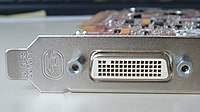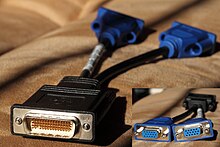
Digital Visual Interface (DVI) is a video display interface developed by the Digital Display Working Group (DDWG). The digital interface is used to connect a video source, such as a video display controller, to a display device, such as a computer monitor. It was developed with the intention of creating an industry standard for the transfer of uncompressed digital video content.

VESA, formally known as Video Electronics Standards Association, is an American technical standards organization for computer display standards. The organization was incorporated in California in July 1989 and has its office in San Jose. It claims a membership of over 300 companies.

Video Graphics Array (VGA) is a video display controller and accompanying de facto graphics standard, first introduced with the IBM PS/2 line of computers in 1987, which became ubiquitous in the IBM PC compatible industry within three years. The term can now refer to the computer display standard, the 15-pin D-subminiature VGA connector, or the 640 × 480 resolution characteristic of the VGA hardware.

A graphics card is a computer expansion card that generates a feed of graphics output to a display device such as a monitor. Graphics cards are sometimes called discrete or dedicated graphics cards to emphasize their distinction to integrated graphics processor on the motherboard or the CPU. A graphics processing unit (GPU) that performs the necessary computations is the main component in a graphics card, but the acronym "GPU" is sometimes also used to erroneously refer to the graphics card as a whole.
The Display Data Channel, or DDC, is a collection of protocols for digital communication between a computer display and a graphics adapter that enable the display to communicate its supported display modes to the adapter and that enable the computer host to adjust monitor parameters, such as brightness and contrast.
Apple Inc. has sold a variety of LCD and CRT computer displays. Apple paused production of their own standalone displays in 2016 and partnered with LG to design displays for Macs. In June 2019, the Pro Display XDR was introduced, however it was expensive and targeted for professionals. Nearly three years later, in March 2022, the Studio Display was launched as a consumer-targeted counterpart to the professional monitor. These two are currently the only Apple-branded displays available.

High-Definition Multimedia Interface (HDMI) is a proprietary audio/video interface for transmitting uncompressed video data and compressed or uncompressed digital audio data from an HDMI-compliant source device, such as a display controller, to a compatible computer monitor, video projector, digital television, or digital audio device. HDMI is a digital replacement for analog video standards.
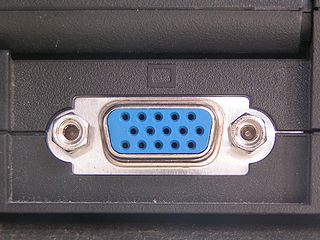
The Video Graphics Array (VGA) connector is a standard connector used for computer video output. Originating with the 1987 IBM PS/2 and its VGA graphics system, the 15-pin connector went on to become ubiquitous on PCs, as well as many monitors, projectors and high-definition television sets.
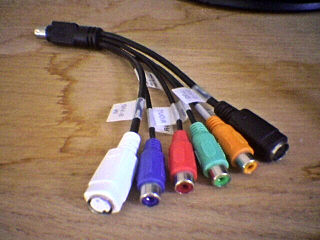
Video in video out, commonly pronounced ( VEE-voh), is a graphics port which enables some video cards to have bidirectional analog video transfer through a mini-DIN connector, usually of the 9-pin variety, and a specialised splitter cable.

DB13W3 (13W3) is a style of D-subminiature connector used for analog video interfaces. The 13 refers to the total number of pins, the W refers to workstation and the 3 refers to the number of high-frequency pins. The connector was something of a pseudo-standard for high-end graphical workstations from the early 1990s to the early 2000s.

DisplayPort (DP) is a digital display interface developed by a consortium of PC and chip manufacturers and standardized by the Video Electronics Standards Association (VESA). It is primarily used to connect a video source to a display device such as a computer monitor. It can also carry audio, USB, and other forms of data.

A low-force helix (LFH-60) is a 60-pin electrical connector with signals for two digital and analog connectors. Each of the pins is twisted approximately 45 degrees between the tip and the plastic frame which holds the pins in place. Hence "helix" in the name.
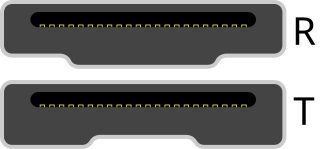
Unified Display Interface (UDI) was a digital video interface specification released in 2006 which was based on Digital Visual Interface (DVI). It was intended to be a lower cost implementation while providing compatibility with existing High-Definition Multimedia Interface (HDMI) and DVI displays. Unlike HDMI, which is aimed at high-definition multimedia consumer electronics devices such as television monitors and DVD players, UDI was specifically targeted towards computer monitor and video card manufacturers and did not support the transfer of audio data. A contemporary rival standard, DisplayPort, gained significant industry support starting in 2007 and the UDI specification was abandoned shortly thereafter without having released any products.

A very-high-density cable interconnect (VHDCI) is a 68-pin connector that was introduced in the SPI-2 document of SCSI-3. The VHDCI connector is a very small connector that allows placement of four wide SCSI connectors on the back of a single PCI card slot. Physically, it looks like a miniature Centronics type connector. It uses the regular 68-contact pin assignment. The male connector (plug) is used on the cable and the female connector ("receptacle") on the device.

The Mini-DVI connector is used on certain Apple computers as a digital alternative to the Mini-VGA connector. Its size is between the full-sized DVI and the tiny Micro-DVI. It is found on the 12-inch PowerBook G4, the Intel-based iMac, the MacBook Intel-based laptop, the Intel-based Xserve, the 2009 Mac mini, and some late model eMacs.

The Dreamcast VGA Box is an accessory for Sega's Dreamcast video game console that allows it to connect to a video display such as a computer monitor or an HDTV set through a VGA port. Because the Dreamcast hardware can produce a VGA-compatible video signal natively, this connection provides improved picture quality compared to standard composite video or S-Video connections, along with support for progressive scan video.

The Mini DisplayPort is a miniaturized version of the DisplayPort audio-visual digital interface.
Audio connectors and video connectors are electrical or optical connectors for carrying audio or video signals. Audio interfaces or video interfaces define physical parameters and interpretation of signals. For digital audio and digital video, this can be thought of as defining the physical layer, data link layer, and most or all of the application layer. For analog audio and analog video these functions are all represented in a single signal specification like NTSC or the direct speaker-driving signal of analog audio.

AMD Eyefinity is a brand name for AMD video card products that support multi-monitor setups by integrating multiple display controllers on one GPU. AMD Eyefinity was introduced with the Radeon HD 5000 Series "Evergreen" in September 2009 and has been available on APUs and professional-grade graphics cards branded AMD FirePro as well.

On June 26, 2007, Dell released the new Inspiron desktop series, under the Dell Inspiron branding, as a replacement to the Dell Dimension desktop computers.
